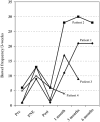Sacral nerve neuromodulation for the treatment of lower bowel motility disorders
- PMID: 17132307
- PMCID: PMC1963799
- DOI: 10.1308/003588406X149174
Sacral nerve neuromodulation for the treatment of lower bowel motility disorders
Abstract
Introduction: Incontinence and constipation are common and cause a high degree of physical, social and psychological impairment. Maximal conservative therapy may improve some patients but many remain symptomatic. Surgical options are often unsatisfactory, with variable result and further options are limited. Sacral nerve stimulation uses electrical stimulation applied to the sacral nerves, eliciting a physiological effect on the lower bowel, anal sphincter and pelvic floor, resulting in clinical benefit. The objective of this study was to investigate whether sacral nerve neuromodulation can improve patients with disorders of bowel motility, when current maximal treatment has failed and to investigate the underlying physiological mechanism of action.
Results: Incontinence: Nineteen patients, age 58 years (range, 37-71 years), with resistant incontinence for 6 years (range, 2-21 years) underwent stimulation. Continence improved in all at 24 months (range, 3-60 months), fourteen fully continent. Incontinent episodes decreased; 12 (range, 2-30) versus 0 (range, 0-4), P < 0.001. Urgency (P < 0.01) and quality of life improved (P < 0.05). Anal squeeze pressure (P = 0.001) and rectal sensation (P < 0.01) improved. Constipation: Four women, (aged 27-36 years) with resistant idiopathic constipation for 8-32 years underwent the first worldwide implants. Symptoms improved in all with temporary, and in three with permanent, stimulation at 8 months (range, 1-11 months). Bowel frequency increased: 1-5 versus 6-28 evacuations/3-weeks. Symptom scores and quality of life improved. Placebo effect: A double-blind, cross-over study was performed to examine placebo effect and efficacy. Once stimulation was removed, in a blinded manner, symptoms, physiological parameters and quality of life measures rapidly returned to baseline levels. Autonomic neuromodulation: Sixteen patients, median age 59 years (range, 38-71 years), were studied at 27 months (range, 2-62 years) using laser Doppler flowmetry. Chronic stimulation was at 2.8 V (range, 0.3-3.9 V). Median flux differed between none and chronic stimulation (P = 0.001). Step-wise increments caused an immediate, dose-dependent rise in flux (P < 0.0001) up to 1.0 V.
Conclusions: This research provides strong evidence that sacral nerve stimulation can improve patients with resistant incontinence and shows proof-of-concept for the treatment of constipation. The effect is unlikely to be due to placebo and the mechanism is rapidly reversible and involves a dose-dependent effect on the autonomic nerves.
Figures


References
-
- Nelson R, Norton N, Cautley E, Furner S. Community-based prevalence of anal incontinence. JAMA. 1995;274:559–61. - PubMed
-
- Thompson WG, Heaton KW. Functional bowel disorders in apparently healthy people. Gastroenterology. 1980;79:283–8. - PubMed
-
- Malouf AJ, Norton CS, Engel A, Nicholls R, Kamm M. Long-term results of overlapping anterior anal-sphincter repair for obstetric trauma. Lancet. 2000;355:260–5. - PubMed
-
- Baeten GMI, Bailey HR, Bakka A, Belliveau P, Berg E, Buie WD, et al. the Dynamic Graciloplasty Therapy Study Group Safety and efficacy of dynamic graciloplasty for fecal incontinence: report of a prospective, multicenter trial. Dis Colon Rectum. 2000;43:743–51. - PubMed
-
- Lehur PA, Glemain P, Bruley des Varannes S, Buzelin JM, Leborgne J. Outcome of patients with an implanted artificial anal sphincter for severe faecal incontinence. A single institution report. Int J Colorect Dis. 1998;13:88–92. - PubMed
Publication types
MeSH terms
LinkOut - more resources
Full Text Sources
Other Literature Sources
Medical

